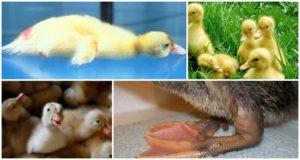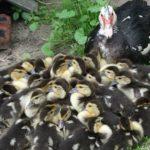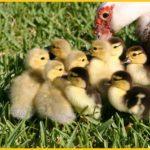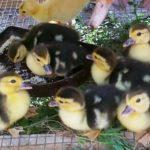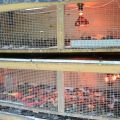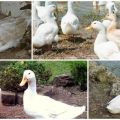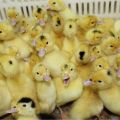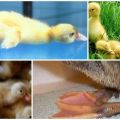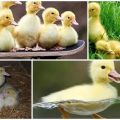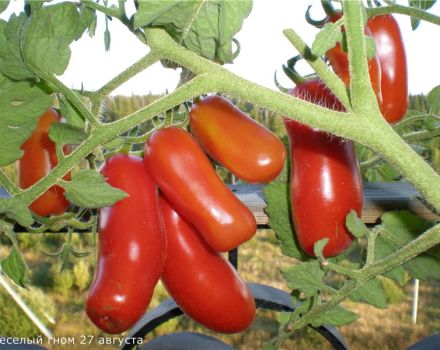Do I need to take the ducklings from the Indo-duck and further actions after hatching
Breeding ducklings at home is not as easy as it sounds, even if ducklings are hatched not in an incubator, but under a duck. It seems that you can entrust everything to the duck and not worry. But what to do with the Indo-ducklings after hatching, take them away from her or not, how to feed and keep them from the first days, what problems can be, not every poultry breeder knows about this. Let's consider these issues in more detail.
Do I need to pick up ducklings from under the duck?
If the duck is calm and proven, there is no need to pick it up. Ducklings, like all poultry chicks, hatch under broods better than in an incubator, and their survival rate is higher - almost 100%. They quickly learn everything the duck teaches them, they get sick less. Many poultry breeders leave a brood with an indow, especially in summer, when it is warm and they are not threatened by hypothermia.
If the musk duck takes care of its offspring, then there is no need to interfere with it. But if it becomes clear that she abandoned the ducklings, which sometimes happens, then the only thing that remains is to pick them up and raise them in a brooder. But there is a situation when you have to take the ducklings even from a caring mother, despite the fact that she responsibly hatched them and does not show any intention to refuse them.
This should be done if a separate room cannot be allocated for an Indo-duck with offspring, where she will live until the ducklings grow up a little.
The fact is that it is impossible to keep a mother and children in a common herd, other Indo-women or drakes can easily trample them. All hens need to be isolated for a while, and if this cannot be done due to lack of free places, then it remains to pick up the ducklings.
Features of keeping ducklings from the first days of birth
If a decision is made to take the ducklings from the Indo-duck, then this should be done as soon as she brought them out. Chicks are placed in a brooder. This is a special device where artificial conditions are created for growing young poultry. A feeder and a drinking bowl are installed in the brooder, an infrared lamp is hung on top, the floor is covered with newspaper and paper, which are changed daily.
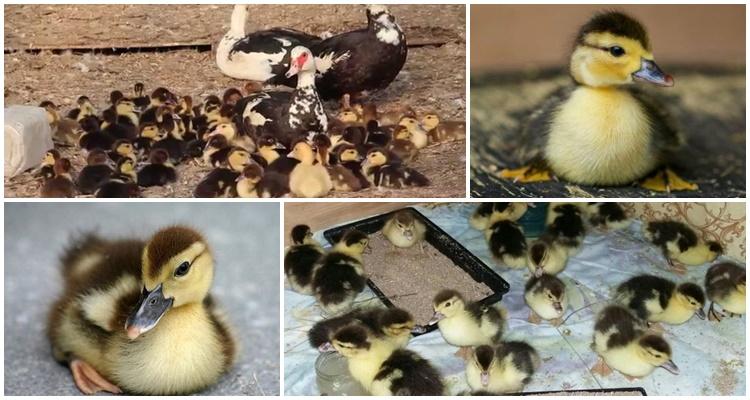
Small chicks, bred by the Indo-female, can be released for walking with their mother, but not in a flock, but separately from everyone. They can swim, so on the walk you can put a shallow container in which the indoor kids will splash. The walking yard must be cleaned of debris, especially from elements that can hurt chicks.
At the same time, if it is cold, then on the first day it is impossible to release an Indoor with babies. Better to leave them in the poultry house, supply water and food.If it is very cold, then either the duck must be moved to a warm room for a while, or a way to heat the house must be found. This must be done, because Indo-girls do not warm up the offspring like chickens, but simply stand, and the chicks sit nearby. Therefore, in a cold house they will freeze.
What to feed
In the first 1-3 days after the ducklings hatch, they are fed with boiled eggs, cottage cheese and herbs, like chickens. Further actions: they are transferred to grain mash, which are made up of finely crushed chaff, boiled vegetables or root vegetables, finely chopped greens, bran. They should be moist, but not sticky. You can cook crumbly porridge, reverse, sour milk. Give duckweed, if you can get it nearby, give more herbs.
In order not to prepare food, you can feed the chicks of the Indo-duck with compound feed. There are starter mixes that can be given to ducklings in the first 1.5 weeks of life.
For 1.5-week-old ducklings, meat wastes, boiled potatoes, vitamin preparations, and mineral premixes are mixed into their food. This is necessary to prevent rickets, to make the immune system stronger. Feeding frequency:
- 1st week - 5-6 times, but little by little;
- up to a month - 4-5 times;
- 1-2 months - 3-4 times;
- before slaughter, as well as adult birds - 2-3 times.
When the ducklings grow up to at least a month, they can be released into a flock. Adult birds will no longer pose a danger to them.

Possible problems
Do not touch ducklings already hatched until all the rest have emerged from the eggs. When an Indoor woman sees that someone is touching her offspring, she often abandons him. Therefore, you need to wait, and then count how many hatched. The main problem that a poultry farmer has with newly hatched ducklings is that not all of them try to eat and drink, some do not know how to do it.
Therefore, until the ducklings learn to eat, you need to make sure everyone has eaten.
Indo-ducks that are fattened for meat are raised until they have accumulated sufficient mass for slaughter. The problem in this case is the difficulty in determining when it is possible to slaughter. Usually, an Indo-duck is slaughtered at the age of 2.5-3 months, since then molting occurs. More needing nutrients, they eat more, but the gains are in no hurry to increase. Therefore, only breeding birds can be left for further cultivation.
Disease prevention
Babies are defenseless, fragile and vulnerable immediately after hatching. Their immunity is still weak, which leads to diseases, the cause of which is insufficient cleanliness in the poultry house. Therefore, the place where the Indo-woman sits must be clean. It is necessary to change the bedding, bathing water, remove the remnants of food in the feeder so as not to sour, and refresh the water.
Simple safety measures reduce the likelihood of infections, which means saving the lives of babies. How to raise ducklings, whether to take them away from the Indo-duck, the poultry farmer decides. Indo-duck, if she is balanced and intelligent, is able to raise offspring herself. It was noticed that under the mother the chicks do not get sick, grow nimbly, and behave actively. There is always a lot of trouble with artificially grown Indo-fowls. Therefore, if everything is fine, there is no need to take them away from the duck.
